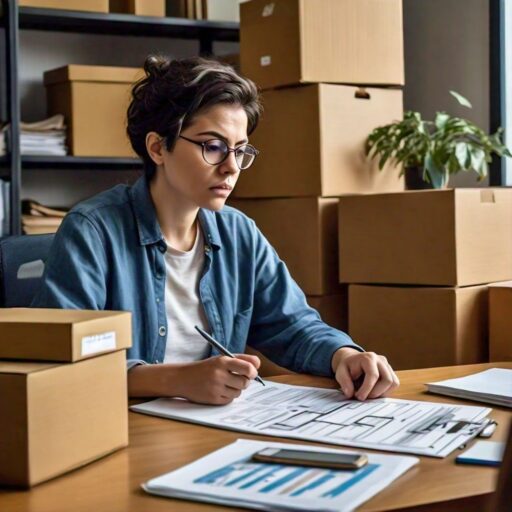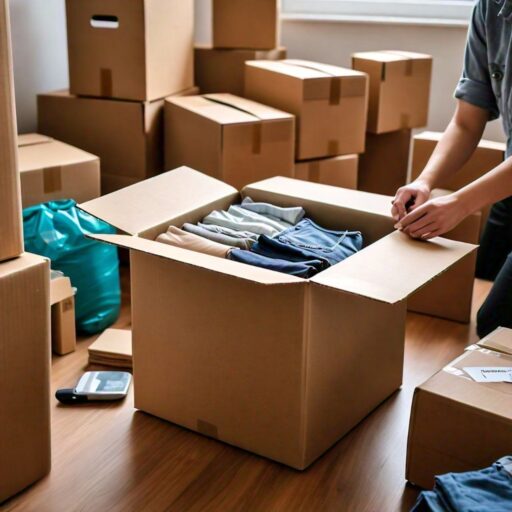Introduction to Home Moving, Packing, Unpacking, Organizing, and Decoration:
Moving to a new home or apartment is a thrilling milestone, full of possibilities and fresh starts. However, the process of house moving, packing, unpacking, organizing, and decorating can also be daunting. People move homes for various reasons, including needing more space, a new job, a fresh start, or a better environment for their family.
Home moving means moving from one home to another. It involves packing, which is putting things in boxes to move them, unpacking, which is taking things out of boxes in the new home, organizing, which is putting things in their place, and decorating, which is making the new home look nice and feel cozy.
This article provides the best tips and information on home moving, packing, unpacking, organizing, and decoration. By using the latest technology and advanced techniques, we ensure that our advice is both practical and easy to follow. Whether you’re moving nearby or to a new city, we aim to make your transition smooth and stress-free.

Content Outlines for Home Moving, Packing, Unpacking, Organizing, and Decoration:
1. Mastering the Art of Moving: Strategic Planning.
2. Smart Packing: Techniques for a Seamless Move.
3. Stress-Free Moving Day: Essential Tips and Tricks.
4. Efficient Unpacking: Organizing Your Belongings.
5. Creating Order: Organize Your New Home Like a Pro.
6. Transforming Your Space: Stylish Decorating Ideas.
7. Settling In: Making Your New Home Feel Like Home.
1. Strategic Planning: Mastering the Art of Moving:
Start with a solid plan to ensure a smooth transition. This section covers how to create a moving plan, budget your expenses, inventory, and Decluttering Before Packing.

1.1. Create a Moving Timeline:
To make your move smooth, start planning early and break down tasks into weekly chunks. Think about everything that needs to be done, like hiring movers, setting up your new home, and packing. Prioritize what’s important, like setting up kids’ rooms first if you’re moving with them. Stay organized, focus on essentials, and adjust your schedule as needed.
1.2. Create a Floor Plan:
Plan by sketching a floor plan for your new home to arrange furniture and cabinets. Take photos of your current and new kitchens to label cabinets effectively. This will help you organize your space and make the most of it. Stay organized and adjust as needed for a smooth move.
1.3. Budget and Inventory:
Craft a detailed budget that includes all possible expenses, from movers to packing supplies and even unexpected costs like last-minute cleaning services. Create an inventory of your belongings, not just for insurance purposes, but to help you decide what to take, sell, or donate. Consider using apps like Sortly to keep track of your items and their condition.
1.4. Decluttering Before Packing:
Moving offers the perfect opportunity to declutter. Go through each room, evaluating what you truly need. Hosting a yard sale can not only help you get rid of unwanted items but also earn some extra cash for your move. Donate items that don’t sell to local charities, and recycle or responsibly dispose of anything else.
2. Smart Packing: Techniques for a Seamless Move:
Learn efficient packing methods to keep your belongings safe and organized. Discover packing supplies, fragile items, advanced packing techniques, labeling boxes, and using space effectively to streamline your move.

2.1. Collect Packing Supplies:
Collect all required packing materials and tools before. This includes boxes, packing tape, bubble wrap, markers, furniture covers, blankets, packing paper, and necessary tools. Having everything on hand will streamline your packing process and ensure you don’t run into any last-minute shortages.
2.2. Taking Pictures for Inventory:
Include the strategy of taking pictures of furniture, appliances, and other items to create a detailed inventory, aiding in determining the number of boxes and their sizes.
2.3. Room-by-Room Packing:
Pack one room at a time to maintain organization. Start with the rooms that you use less frequently, like guest rooms or storage spaces. Be sure to label each box with its contents and the corresponding room in your new home. You can also use color-coded labels for easier identification.
2.4. Advanced Packing Techniques:
Vacuum-Sealing Clothes: Maximize space in boxes and prevent moisture damage by vacuum-sealing clothes.
Packing in Layers: Use a layer of packing material at the bottom of each box, followed by heavier items, and finish with lighter items on top.
Handling Hazardous Materials: Safely pack and move items like cleaning supplies or paint, and know which items might need to be transported separately.
2.5. Packing Fragile and Valuable Items:
Wrap fragile items like glassware and china individually in bubble wrap or packing paper. Use towels or clothing to fill empty spaces in boxes, preventing movement during transit. Label these boxes as “fragile” and consider packing them separately from heavier items.
2.6. Electronics and Furniture:
If you have the original boxes for electronics, use them. Before disassembling electronic setups, take photos of the cable arrangements for easy reassembly. For large furniture, disassemble what you can, and protect the rest with furniture covers or moving blankets. Consider hiring a professional for items that require special handling, like pianos or antique furniture.
2.7. Essential Box:
Pack an essential box with items you’ll need immediately after moving—think toiletries, a few days’ worth of clothes, important documents, and basic kitchen supplies. This box should be easily accessible during the move, so consider transporting it in your car rather than the moving truck.
3. Stress-Free Moving Day: Essential Tips and Tricks:
Make your moving day as smooth as possible with practical tips. This section includes advice on coordinating with movers, managing the weather, and keeping essential items accessible.

3.1. Weather Considerations:
Be prepared for the weather on a moving day. If it’s raining, have tarps or plastic covers ready to protect your belongings. In extreme heat or cold, plan breaks and stay hydrated.
3.2. Communication with Movers:
Ensure clear communication with your movers. Discuss the plan for the day, point out fragile items, and supervise the loading process to avoid mishaps.
3.3. Keep Essentials Accessible:
Have a moving-day survival kit with snacks, water, phone chargers, and first-aid supplies. Keep this kit with you to ensure you have everything you need within reach.
4. Efficient Unpacking: Organizing Your Belongings:
Unpack with ease by focusing on essentials first and methodically organizing each room. This part provides strategies for quick and efficient unpacking to get you settled in faster.

4.1. Unpacking Essentials First:
Begin by unpacking the essentials for the kitchen, bedrooms, and bathrooms. Setting up the kitchen first allows you to prepare meals, and ensuring the beds are ready will provide a much-needed place to rest for your children and yourself after a long day.
4.2. Room-by-Room Unpacking:
Just as you packed room by room, unpack in the same way. Start with the most important spaces, like the bedrooms and living room, to maintain order and avoid feeling overwhelmed by scattered boxes. Use the photos you took during packing to help recreate cable setups and furniture arrangements.
4.3. Efficient Disposal of Packing Materials:
As you unpack, break down, and recycle moving boxes. Save bubble wrap and packing paper for future use, or consider donating them. For boxes in good condition, pass them on to someone else who’s moving, or check with local recycling centers for disposal options.
5. Creating Order: Organize Your New Home Like a Pro:
Transform your new home into a well-organized space. Learn how to plan your layout, maximize storage, and keep everything in its place with effective organization tips.

5.1. Functional Layout Planning:
Before moving large furniture, measure your new space and plan a layout that optimizes flow and utility. Use painter’s tape to mark where furniture will go, ensuring everything fits as intended. Consider traffic flow and how natural light enters the room when arranging furniture.
5.2. Kitchen and Closet Organization:
In the kitchen, group similar items together for easy access, and use drawer dividers and shelf risers to maximize storage solutions. For closets, invest in matching hangers and storage bins to keep things tidy and visually appealing. Label bins for easy identification, especially for seasonal items or items stored on high shelves.
5.3. Utilize Vertical Space:
Maximize storage by using vertical space in closets and storage areas. Install shelves or use stackable bins to keep items organized and accessible. For small kitchen spaces, consider wall-mounted hooks or over-the-door organizers to keep essentials within reach.
6. Transforming Your Space: Stylish Decorating Ideas:
Personalize your new home with stylish decorating ideas. This section offers tips on choosing decor, arranging furniture, and adding decorative touches to make your space unique.

6.1. Personalizing Your Space:
Begin by identifying your style—whether it’s modern, traditional, western, or eclectic decor. Create a mood board with digital collections or magazine cutouts of spaces that inspire you. This will guide your decorating decisions and help you choose a cohesive color palette. Consider incorporating local artwork or handmade items that reflect your journey.
6.2. Room-Specific Decorating Tips:
Living Room: Anchor the space with a rug, and layer lighting with ambient, task, and accent lights. Add personal touches like family photos or artwork to make it feel like home. Consider using multifunctional furniture like ottomans with storage to maximize space.
Bedroom: Invest in quality bedding, incorporate soft textures with throws and pillows, and keep the bedroom clutter-free for a relaxing environment. Adding blackout curtains can enhance sleep quality, especially if your new home is in a busy area.
Kitchen: Use open shelving for your favorite dishes, and incorporate greenery with fresh herbs or small plants to add life and color. Consider practical decor, like a stylish fruit bowl or a magnetic knife strip, to keep the space functional yet aesthetically pleasing.
6.3. Final Touches:
The final touches make your home truly yours. Incorporate scents with candles, diffusers, or fresh flowers. Hang artwork that reflects your style, and layer textiles for warmth and comfort. Display personal items like books, travel souvenirs, or family heirlooms to add character and tell your story.
7. Settling In Making Your New Home Feel Like Home:
Settle into your new surroundings with ease. Find out how to address practical needs, introduce yourself to the neighborhood, and create a welcoming environment to feel at home quickly.

7.1. Home Safety Checks:
Once you’ve moved in, conduct a thorough check of your new home for any issues like leaks, electrical problems, or pest infestations. Address these promptly to avoid future problems.
7.2. Neighbor Introduction:
Introduce yourself to your new neighbors. A friendly introduction can help you integrate into the community and make your new neighborhood feel like home.
7.3. Setting Up Utilities:
Efficiently set up utilities, internet, and other essential services. Contact providers ahead of time to ensure services are activated before or shortly after your move.
Conclusion:
A new home move can be a thrilling adventure and a stressful experience all at once. This article aims to provide you with comprehensive guidance on every step of the home moving process, from planning and packing to unpacking, organizing, and decorating your new space. Our goal is to equip you with practical and actionable tips to ensure a smooth transition from your old home to your new one.
By leveraging our insights, you’ll be able to navigate the complexities of moving with confidence and ease, transforming your new house into a welcoming and functional home. Whether you’re tackling packing strategies or seeking creative decorating ideas, we’ve gathered expert advice and innovative techniques to make your move as seamless as possible.
FAQs:
What should I include in my moving plan?
Your moving plan should include a timeline, a list of tasks, a budget, and a list of things to pack. Don’t forget to schedule utility shut-offs and set up services in your new home.
What are the best packing materials for fragile items?
Use bubble wrap, packing paper, and sturdy boxes. Fill empty spaces with towels or clothing to prevent movement.
How can I keep track of all my belongings?
Create an inventory list or take pictures of items and their condition. This will help ensure nothing is lost or damaged during the move.
What’s the most effective way to pack electronics?
Use the original boxes if available. Otherwise, pack electronics in padded boxes and take photos of cable arrangements for easy reassembly.
How do I handle hazardous materials?
Pack hazardous materials like cleaners and paint separately, following safety guidelines, and check if they need special handling during the move.
How can I prevent damage to furniture during the move?
Disassemble furniture if possible, and use moving blankets or covers. For delicate items, consider professional movers.
What are some advanced packing techniques?
Vacuum-seal clothes to save space, pack heavier items at the bottom of boxes and use layers of packing material for added protection.
What should I consider when decorating a new home?
Focus on a cohesive color scheme, photos, artwork, and familiar décor; choose furniture that fits the space, and incorporate elements that reflect your style.
How do I manage moving costs effectively?
Create a moving budget, get quotes from moving companies, and plan for any additional expenses, such as packing materials or temporary lodging.
What are common moving day problems, and how can I address them?
Common issues include delays and damaged items. Prepare by having a backup plan, ensuring all items are properly packed, and communicating clearly with movers.

